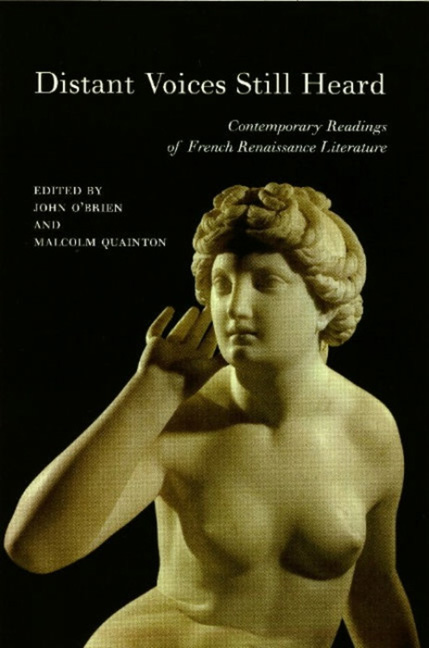Book contents
- Frontmatter
- Contents
- Editors’ Foreword
- Introduction: The Time of Theory
- 1 The Highs and Lows of Structuralist Reading: Rabelais, Pantagruel, chapters 10—13
- 2 Rabelais’ Strength and the Pitfalls of Methodology: Tiers Livre, chapters 7–18
- 3 ‘Blond chef, grande conqueste’: Feminist Theories of the Gaze, the blason anatomique and Louise Labé's Sonnet 6
- 4 Louise Labé's Feminist Poetics
- 5 Reading and Writing in the Tenth Story of the Heptaméron
- 6 Fetishism and Storytelling in Nouvelle 57 of Marguerite de Navarre's Heptaméron
- 7 Creative Choreography: Intertextual Dancing in Ronsard's Sonnets pour Hélène: II, 30
- 8 An Overshadowed Valediction: Ronsard's Dedicatory Epistle to Villeroy
- 9 ‘De l'amitié’ (Essais 1.28): ‘Luy’ and ‘Moy’
- 10 Montaigne's Death Sentences: Narrative and Subjectivity in ‘De la diversion’ (Essais 3.4)
- Select Bibliography
- Index
7 - Creative Choreography: Intertextual Dancing in Ronsard's Sonnets pour Hélène: II, 30
- Frontmatter
- Contents
- Editors’ Foreword
- Introduction: The Time of Theory
- 1 The Highs and Lows of Structuralist Reading: Rabelais, Pantagruel, chapters 10—13
- 2 Rabelais’ Strength and the Pitfalls of Methodology: Tiers Livre, chapters 7–18
- 3 ‘Blond chef, grande conqueste’: Feminist Theories of the Gaze, the blason anatomique and Louise Labé's Sonnet 6
- 4 Louise Labé's Feminist Poetics
- 5 Reading and Writing in the Tenth Story of the Heptaméron
- 6 Fetishism and Storytelling in Nouvelle 57 of Marguerite de Navarre's Heptaméron
- 7 Creative Choreography: Intertextual Dancing in Ronsard's Sonnets pour Hélène: II, 30
- 8 An Overshadowed Valediction: Ronsard's Dedicatory Epistle to Villeroy
- 9 ‘De l'amitié’ (Essais 1.28): ‘Luy’ and ‘Moy’
- 10 Montaigne's Death Sentences: Narrative and Subjectivity in ‘De la diversion’ (Essais 3.4)
- Select Bibliography
- Index
Summary
One of the initial difficulties facing the twentieth-century reader of French Renaissance poetic texts in general (and amatory utterances in particular) is that s/he must divest her/himself of anachronistic (post-Romantic?) hermeneutic models which mechanistically equate sincerity and lived experience with originality, inspiration and creative excellence. It is often a challenging and painful process (for both teacher and student alike!) not only to have such comforting assumptions subverted, but also to have to contend, firstly, with such notions as (creative) imitation, rhetorical writing strategies, conventions and received topoi, and, secondly, to learn to trace the distinctive nature and the value of a poem to the ways in which received norms are personalised, rejuvenated and transcended by technical craftsmanship, by subtle deviations and patterns of emphasis and foregrounding, and by other complex and allusive processes of intertextual adaptation.
It is perhaps only natural, therefore, that a surface reading of the much-admired dance blason from Ronsard's Sonnets pour Hélène should first of all seek to anchor the text in the poet's autobiography and personal witness, before acknowledging the manner in which this (apparent) lived experience interfaces ambiguously with, and is mediated through, classical reminiscence and variations of familiar Petrarchist stylistics (antithesis, hyperbole, synecdoche) and concetti – the innamoramento (the first meeting) and the effect on the lover-poet of the woman's artistic accomplishments (here dancing, but, often, her singing or playing musical instruments), the omnipotence of love, the power of the eyes and the divinity of the woman:
Le soir qu'Amour vous fist en la salle descendre
Pour danser d'artifice un beau ballet d'Amour,
Vos yeux, bien qu'il fust nuict, ramenerent le jour,
Tant ils sceurent d'esclairs par la place respandre. 4
Le ballet fut divin, qui se souloit reprendre,
Se rompre, se refaire, & tour dessus retour
Se mesler, s'escarter, se tourner à l'entour,
Contre-imitant le cours du fleuve de Meandre. 8
Ores il estoit rond, ores long, or’ estroit,
Or’ en poincte, en triangle, en la façon qu'on voit
L'escadron de la Gruë evitant la froidure.
Je faux, tu ne dansois, mais ton pied voletoit 12
Sur le haut de la terre: aussi ton corps s'estoit
Transformé pour ce soir en divine nature.
- Type
- Chapter
- Information
- Distant Voices Still HeardContemporary Readings of French Renaissance Literature, pp. 155 - 170Publisher: Liverpool University PressPrint publication year: 2000



